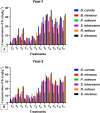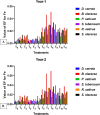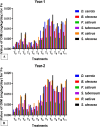Assessment of iron accumulation in vegetables cultivated with excessive application of organic and inorganic fertilizers along with various water sources
- PMID: 40691761
- PMCID: PMC12278573
- DOI: 10.1186/s12870-025-06941-9
Assessment of iron accumulation in vegetables cultivated with excessive application of organic and inorganic fertilizers along with various water sources
Abstract
Irrigation with sewage water can offer benefits such as increased crop productivity, but it also has significant drawbacks that affect crops, soil quality, and human health. Given its diverse composition of toxins, including chemicals and heavy metals, sewage water can adversely impact both soil fertility and crop health. With this in mind, the objective of this research was to evaluate the potential health risks associated with iron (Fe) in vegetables, specifically leafy and root vegetables, irrigated with wastewater, canal water, and a combination of organic and inorganic fertilizers. Water, soil, and edible components of food crops were randomly sampled from different treatments (T0-T11). The concentration of iron (Fe) in these samples was determined via an atomic absorption spectrophotometer, which employs the wet digestion method for sample preparation. The concentrations of iron (Fe) ranged from 0.4672 mg/L to 1.083 mg/L in water, 5.702 to 46.633 mg/kg in soil, and 192.57-58.49 mg/kg in crop samples. These values were within the permissible limits set by the World Health Organization (WHO). Additionally, various indices, including the bioconcentration factor (BCF), enrichment factor (EF), daily intake of metals (DIM), and health risk index (HRI), were found to be less than 1. These findings suggest that the levels of Fe in vegetables suggest a low potential for health risks under current exposure levels. However, the pollution load index exceeded 1, indicating soil contamination. Despite this, there are no indications of Fe toxicity in crops, nor are there identified health risks or carcinogenic risks associated with the consumption of these food crops by humans. To mitigate the risk of excessive accumulation of iron (Fe) in the food chain, regular monitoring is essential.
Keywords: Heavy metals; Human health; Inorganic fertilizers; Vegetables; Wastewater irrigation.
© 2025. The Author(s).
Conflict of interest statement
Declarations. Ethics approval and consent to participate: The Institutional Ethics and Guideline Committee of the University of Sargodha (Approval No. 38-B33/2020 UOS) has allowed all the protocols used in this experiment. All the experimental methods used in this study followed all the appropriate guidance and regulations. Consent for publication: All the subjects gave their “informed consent” for the publication of details within the text (“informed consent”) to be published in the above Journal and Article. Written “informed consent” was obtained from all the authors for the publication of this manuscript. Competing interests: The authors declare no competing interests.
Figures








Similar articles
-
Health risk assessment and bioaccumulation of potentially toxic metals from water, soil, and forages near coal mines of district Chakwal, Punjab, Pakistan.Environ Geochem Health. 2023 Jul;45(7):5441-5466. doi: 10.1007/s10653-023-01531-w. Epub 2023 Apr 7. Environ Geochem Health. 2023. PMID: 37029254
-
The Black Book of Psychotropic Dosing and Monitoring.Psychopharmacol Bull. 2024 Jul 8;54(3):8-59. Psychopharmacol Bull. 2024. PMID: 38993656 Free PMC article. Review.
-
Long term urban wastewater irrigation drives zinc bioaccumulation and health risks in contaminated vegetables.Sci Rep. 2025 Jul 1;15(1):21290. doi: 10.1038/s41598-025-06026-5. Sci Rep. 2025. PMID: 40594267 Free PMC article.
-
Multivariate analysis of potential health hazards of manganese via dietary exposure of widely consumed vegetables amended with municipal solid waste.Environ Geochem Health. 2025 Jun 4;47(7):247. doi: 10.1007/s10653-025-02559-w. Environ Geochem Health. 2025. PMID: 40467910
-
Sertindole for schizophrenia.Cochrane Database Syst Rev. 2005 Jul 20;2005(3):CD001715. doi: 10.1002/14651858.CD001715.pub2. Cochrane Database Syst Rev. 2005. PMID: 16034864 Free PMC article.
References
-
- Natasha, Shahid M, Khalid S, Murtaza B, Anwar H, Shah AH, Sardar A, Shabbir Z, Niazi NK. A critical analysis of wastewater use in agriculture and associated health risks in Pakistan. Environ Geochem Health. 2023;45:5599–618. 10.1007/s10653-020-00702-3. - PubMed
-
- Khan ZI, Ahmad K, Batool F, Wajid K, Mehmood N, Ashfaq A, Ullah S. Evaluation of toxic potential of metals in wheat crop grown in wastewater-contaminated soil in punjab, Pakistan. Environ Sci Pollut Res. 2019;26(24):24958–66. - PubMed
-
- Schröder P, Sauvêtre A, Gnädinger F, Pesaresi P, Chmeliková L, Doğan N, Gerl G, Gökçe A, Hamel C, Millan R, Persson T. Discussion paper: sustainable increase of crop production through improved technical strategies, breeding and adapted management–A European perspective. Sci Total Environ. 2019;678:pp146–161. - PubMed
-
- Ahmad K, Khan ZI, Ashfaq A, Ashraf M, Yasmin S. Assessment of heavy metal and metalloid levels in spinach (Spinacia Oleracea L.) grown in wastewater irrigated agricultural soil of sargodha, Pakistan. Pak J Bot. 2014;46(5):1805–10.
-
- Khan ZI, Ahmad K, Rehman S, Siddique S, Bashir H, Zafar A, Sohail M, Ali SA, Cazzato E, De Mastro G. Health risk assessment of heavy metals in wheat using different water qualities: implication for human health. Environ Sci Pollut Res. 2017;24:947–55. - PubMed
MeSH terms
Substances
Grants and funding
- RGP2/204/46/Researchers supporting the project under grant number RGP2/204/46 at King Khalid University, Saudi Arabia.
- RGP2/204/46/Researchers supporting the project under grant number RGP2/204/46 at King Khalid University, Saudi Arabia.
- RGP2/204/46/Researchers supporting the project under grant number RGP2/204/46 at King Khalid University, Saudi Arabia.
- RGP2/204/46/Researchers supporting the project under grant number RGP2/204/46 at King Khalid University, Saudi Arabia.
- RGP2/204/46/Researchers supporting the project under grant number RGP2/204/46 at King Khalid University, Saudi Arabia.
LinkOut - more resources
Full Text Sources
Medical

